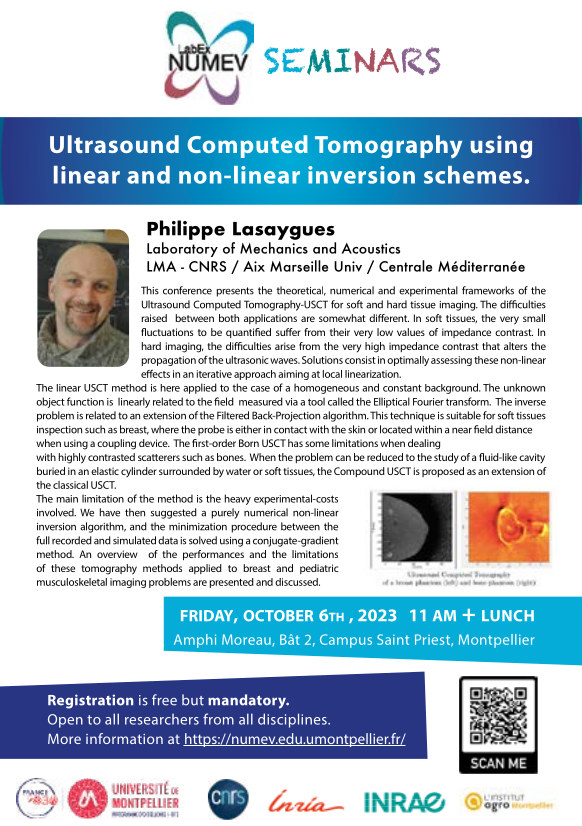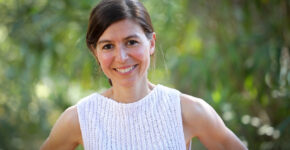NUMEV seminar "Acoustic tomography: background, assessment, prospects and experimental research tools".
This event is over!
The NUMEV Seminars are open to a wide audience of students and researchers from all disciplines, who wish to find out more about the current research areas of the NUMEV-MIPS (Mathematics, Informatics, Physics and Systems) community, or about opportunities to develop their skills and know-how.

Acoustic tomography
Background, results, outlook and experimental research tools
Philippe Lasaygues
Aix Marseille Univ, CNRS, Centrale Marseille,
LMA UMR 7031, Marseille, France
The aim of tomography is to produce cross-sectional images of objects. X-ray tomography (or scannography), the benchmark technique in this field, achieves this using X-rays. Acoustic tomography attempts to do the same using acoustic waves: either ultrasound waves in biomedical applications and non-destructive testing, or sound waves or even infrasound waves (depending on the scale of interest) in geophysics (Lefebvre et al. 2009). Acoustic probing signals (usually broadband pulses) are sent to the object to be imaged from transmitters positioned at a number of points outside the object, the field transmitted or diffracted by the object is captured using transducers also positioned outside the object, and the data is inverted using ad-hoc algorithms.
But what's the difference between ultrasound (long known as echotomography) in the medical and geophysical fields, and acoustic tomography? The essential difference lies in the formulation of the problem, posed in terms of an inverse problem in tomography, and in terms of the physical focusing of waves in echography and synthetic focusing in seismic-reflection. The means used are mathematical and numerical in the case of inverse problems and synthetic focusing (a technique that has been successfully transposed from the field of geophysics to non-destructive ultrasonic testing)(Lefebvre 1994), and physical (lenses) and/or electronic (antenna processing) in the case of echography. In the end, we show that the difference between synthetic focusing and tomography is quite tenuous: the former is in fact only an approximate version, degraded but often sufficient, of the latter.
In tomography, a distinction is made between transmission tomography (transmitter and receiver on opposite sides of the object) and reflection and diffraction tomography (transmitter and receiver on the same side of the object)(Lefebvre et al. 2009). Both are based, at least for their basic formalism, on the assumption of low object heterogeneity and low acoustic impedance contrast with respect to the host medium, so that a straight-ray approximation can be used for transmission modelling and a Born approximation for diffraction modelling. Such an approximation makes perfect sense in the biomedical field for soft tissues, which are known to consist essentially of water; hence the large number of long-standing works in the field of biomedical ultrasound tomography, particularly for female breast imaging (Lasaygues et al. 2002; Mensah et al. 2011).
For several years now, however, the field of application of ultrasound tomography has been extended to musculoskeletal tissues of the lower limbs (arms) and upper limbs (legs) containing one or two long bones (Lasaygues et al. 2022). The linear approximations previously used to examine soft tissues are no longer valid, and severely limit the use of tomography (and ultrasound too). Nevertheless, in children, whose bones are still immature and cartilaginous, certain limits can be overcome by non-linear approaches to inversion, and ultrasound tomography imaging is conceivable (Doveri et al. 2021), even going so far as to parameterize mapping by associating a gray level with one or two acoustic parameters such as ultrasound velocity or attenuation (Doveri et al. 2022).
The introductory presentation will cover the basics of acoustic propagation and diffraction, associated electroacoustics (transducers, acoustic field, focusing) and ultrasound and tomographic imaging. Basic mathematical formulations will be recalled, and developed to move from imaging low-contrast media, such as fibrous breast tissue, to more high-contrast media, such as the musculoskeletal tissues of children.
"Ultrasound Computed Tomography using linear and non-linear inversion schemes
From soft (breast) to hard (pediatric bones) tissue imaging".
Philippe Lasaygues
Laboratoire de Mécanique et d'Acoustique -Laboratory of Mechanics and Acoustics
LMA - CNRS / Aix Marseille Univ / Centrale Méditerranée
Aix Marseille Univ, CNRS, Centrale Marseille, LMA UMR 7031, Marseille, France
This conference presents the theoretical, numerical and experimental frameworks for the Ultrasound Computed Tomography-USCT for soft and hard tissue imaging. The difficulties between both applications raised are somewhat different. In soft tissues, the very small fluctuations to be quantified suffer from their very low values of impedance contrast. This poor echogenic index generally induces low detection probability, for instance in the case of large diffuse masses. In hard imaging, the difficulties arise from the very high impedance contrast that alters the propagation of the ultrasonic waves. Solutions consist in optimally assessing these non-linear effects in an iterative approach aiming at local linearization. The linear USCT method based on the use of the first-order Born approximation, applied to the case of a homogeneous and constant background is described. The unknown object function, which is assumed to be weakly heterogeneous, is linearly related to the field measured via a tool called the Elliptical Fourier transform. The inverse problem is related to an extension of the Filtered Back-Projection (FBP) algorithm. This technique is suitable for soft tissues inspection such as breast, where the probe is either in contact with the skin or located within a near field distance when using a coupling device (water bag or water tank). The first-order Born USCT has some limitations when dealing with highly contrasted scatterers such as bones.
When the problem can be reduced to the study of a fluid-like cavity buried in an elastic cylinder surrounded by water or soft tissues, the Compound USCT is proposed as an extension of the classical USCT, by taking into account physical phenomena such as wave refraction.
The main limitation of the method is the heavy experimental-costs involved (multiple iterative experiments) [1]. We have then suggested a purely numerical non-linear inversion algorithm, and the minimization procedure between the full recorded and simulated data is solved using a conjugate-gradient method mainly developed in non-destructive testing domain or an efficient quasi-Newton technique mainly developed in seismology (full waveform imaging method).
An overview of the performances and the limitations of these tomography methods applied to breast and pediatric musculoskeletal imaging problems are presented and discussed.
References
Doveri E, Baldisser J, Sabatier L, Long V, Espinosa L, Guillermin R, et al. Quantitative anatomical imaging by ultrasound diffraction tomography. 16th Congrès Fr. Acoust. Marseille; 2022.
Doveri E, Sabatier L, Long V, Lasaygues P. Reflection-Mode Ultrasound Computed Tomography Based on Wavelet Processing for High-Contrast Anatomical and Morphometric Imaging. Appl. Sci. 2021 Oct 9;11(20):9368.
Lasaygues P, Espinosa L, Bernard S, Petit P, Guillermin R. Ultrasound Computed Tomography. In: Laugier P, Grimal Q, editors. Bone Quant. Ultrasound New Horiz. P. Laugier&Q. Grimal. Springer
International Publishing; 2022. p. 227-50.
Lasaygues P, Tanne D, Mensah S, Lefebvre JP. Circular Antenna for Breast Ultrasonic Diffraction
Tomography. Ultrason. Imaging. 2002 Jul;24(3):177-89.
Lefebvre J-P. Progress in linear inverse scattering imaging: NDE application of Ultrasonic Reflection
Tomography. Inverse Probl. Eng. Mech. Rotterdam/Brookfield: A.A.Balkema; 1994. p. 371-5.
Lefebvre J-P, Lasaygues P, Mensah S. Acoustic Tomography, Ultrasonic Tomography. In: Bruneau M,
Potel C, editors. Mater. Acoust. Handb. [Internet]. London, UK: ISTE; 2009 [cited 2016 Apr 3]. p. 887-
906. Available from: http://doi.wiley.com/10.1002/9780470611609.ch35
Mensah S, Rouyer J, Lasaygues P, Franceschini E. Ultrasound mammograph for breast lobe inspection.
IEEE; 2011 [cited 2015 Dec 9]. p. 1399-402. Available from:
http://ieeexplore.ieee.org/lpdocs/epic03/wrapper.htm?arnumber=6293561
Receive a weekly summary of the UM agenda
* By entering your e-mail address you agree to receive the weekly UM agenda summary by e-mail and you acknowledge our privacy policy. You can unsubscribe at any time using the unsubscribe link or by contacting us by e-mail.
